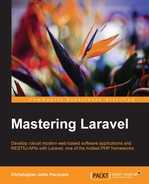To pass an ID to a route, as is common during the display of a single accommodation, the code would be as follows:
/**
* Display the specified resource.
* @Get("/accommodation/{id}")
*/This DocBlock annotation would be placed above the function inside the class, which is similar to the previous example.
To limit the ID to one or more digits, an @Where annotation can be used as follows:
@Where({"id": "d+"})Both the annotations are combined together as shown in the following code:
/**
* Display the specified resource.
* @Get("/accommodation/{id}")
* @Where({"id": "d+"})
*/To add middleware to the example, which limits the request to only authenticated users, the @Middleware annotation may be used:
/**
* Display the specified resource.
* @Get("/accommodation/{id}")
* @Where({"id": "d+"})
* @Middleware("auth")
*/..................Content has been hidden....................
You can't read the all page of ebook, please click here login for view all page.
